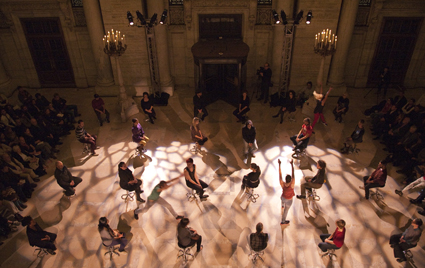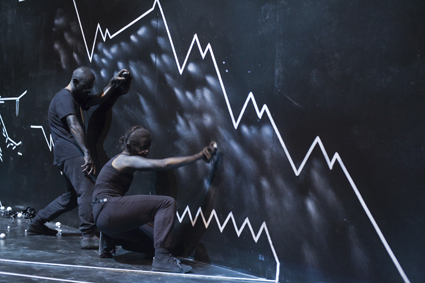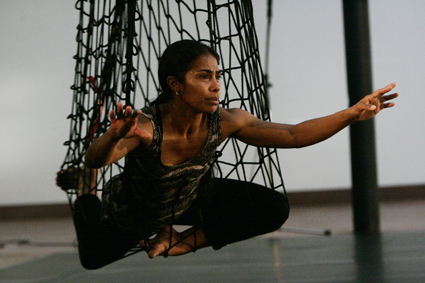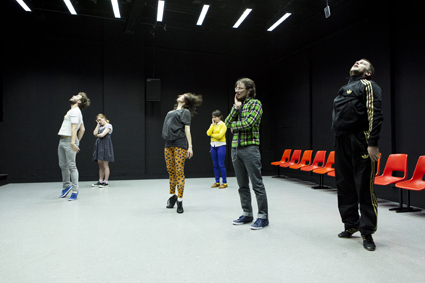an intense manifestation of dance
philipa rothfield: dance massive 2013, melbourne

Lee Serle, P.O.V
photo Bart Michaels for Rolex
Lee Serle, P.O.V
FOR DANCE MASSIVE 2013, ARTS HOUSE, MALTHOUSE THEATRE AND DANCEHOUSE HAVE SELECTED 19 WORKS TO BE PERFORMED OVER TWO WEEKS IN MARCH IN THE ONLY FESTIVAL EXCLUSIVELY DEDICATED TO AUSTRALIAN DANCE.
The program, though kinaesthetically and thematically diverse, nevertheless reflects a number of common interests especially around notions of society, culture and the body. What kind of entity is the individual self? What is its relation to the social whole? How do selves coalesce?
The notion of repetition is another common Dance Massive theme, a mechanism which promises to be explored physically, linguistically, temporally and perceptually. Taken together, these works represent an intense manifestation, a critical mass, of dance culture in an Australian setting.
Why program so many dance works in such a short space of time? Dance Massive proposes an intensity, a shared focus between a roving, active population of spectators and performers not often achieved in Australia, at least, not in dance. According to Angela Conquet (Artistic Director, Dancehouse) a festival such as this can give an accurate, layered picture of the Australian dance landscape. This is not to say that everyone is represented here. Undoubtedly, some companies and artists are in between works. The very selection process, with finite resources and the exercise of choice, also rules out the participation of some. Landscapes are never all-inclusive. They have their own physiognomy, their own borders, topography and temporal flavour. So there is also a contingency to this festival. It is the expression of a critical mass, not an encyclopaedia. It is also an expression of place, of what can be generated in such a setting.
Dance Massive has a twin focus. On the one hand, it’s an opportunity for an audience to serially immerse itself in a multiplicity of works. On the other, it will enable a delegation of 20-odd international visitors to see full-length Australian works in their own cultural milieu. This differs from the narrower arts market concept which showcases and commodifies abridged pieces back-to-back for an international clientele. The exposure to a significant international audience means that Dance Massive offers an opportunity to show developed works which could tour both nationally and internationally. For this reason, Conquet says that this is not a forum for works-in-progress. According to Angharad Wynne-Jones (Creative Producer, Arts House), Dance Massive represents artists at quite different stages of their careers. Like the European platform, Dance Massive has the support of state cultural agencies—the Australia Council and Arts Victoria—but its artistic program is the child of the three venues, their artistic directors and selection committees. Angela Conquet is very appreciative of the dance literacy and involvement of Phillip Keir (Keir Foundation), one of the selectors and a key supporter of the Dancehouse program.
inside the program

Antony Hamilton, Melanie Lane, Black Project 1
photo Ponch Hawkes
Antony Hamilton, Melanie Lane, Black Project 1
A number of the programmed works embody social and political concerns. Ashley Dyer’s Life Support, for example, follows Something Fell on my Head, both of which give their audience the opportunity to directly experience their subject matter, whether through feelings of anxiety, finitude or vulnerability. Antony Hamilton (Black Project 1 & 2, see RT111 and RT108) and Tim Darbyshire (More or Less Concrete, see RT109), in their own ways, also mediate contemporary political and social issues. Atlanta Eke’s meditation on female mutability, Monster Body (RT110), is posed on a feminist present, while Jo Lloyd’s Future Perfect muses on constellations of identity in the cosmos of social life. Stephanie Lake’s Dual reflects the individual’s ability to cleave to the other thereby producing a new, synthetic entity. Whereas Lloyd poses the group in relation to the individual, Lake is interested in the notion of partnership, as embodied in duet form. In Black Project 1& 2, Antony Hamilton explores another kind of interplay within and without the human, between life and non-life, an unstable cosmos.

Dalisa Pigram, Gudirr Gudirr, Marrugeku
photo Rod Hartvigsen
Dalisa Pigram, Gudirr Gudirr, Marrugeku
The social and cultural sphere has several modes of incarnation. Dalisa Pigram’s solo work, Gudirr Gudirr, simultaneously spans the collective concerns of Northwestern Aboriginal people through the singularity and cultural breadth of her own body. Soo Yeun You’s Gu:t collaboratively enters aboriginal spirituality through the lens of her own shamanistic background, felt at the level of the kinaesthetic everyday. Not that every body isn’t in some sense a product of culture, time and motion.
While Russell Dumas’ fine work is indebted to the postmodern choreographic legacy of Twyla Tharp and Trisha Brown, his dance for the time being—Southern Exposure has a local inflexion. As a manifestation of what is possible in the space and time of Australian dancing, Dumas’ work is formulated over the abyss of the present. Dumas “reimagines the unstable body” in relation to the (im)possibility of a future dance practice. Nothing is fixed. Likewise, Ben Speth’s WeTubeLIVE (RT112) feeds on an unstable, undetermined network of possibility. Its mode of community is enactive, a mass playing out of virtual choreographies ripped from the internet and staged for live capture in the dappled kaleidoscope of the National Gallery’s Great Hall. While Speth, Dumas and Pigram are each in their own way oriented towards the future, Tracie Mitchell’s dance film retrospective shows film’s enduring ability to reach into the present.

Conversation Piece, Lucy Guerin Inc
photo Brett Boardman
Conversation Piece, Lucy Guerin Inc
If Larissa McGowan (Skeleton; see interview, p26) is concerned with the bare bones of the anatomical trace, The Recording continues Sandy Parker’s prior interest in the dynamic physiology of a work. Whereas the earlier Document (interview RT103; review RT105) was oriented towards the marks on the page or screen, The Recording aims to open up the process whereby live dancing becomes a series of cinematic images. Difference provokes transformation. This is also a factor in Lucy Guerin’s work, Conversation Piece (interview RT110; review RT111) which plays on the changes set in motion through repetition. Paradoxically, repetition does not engender serial sameness but is the means by which difference is produced. Words and movement played again institute an event, the becoming different of something recognisably the same. Matthew Day also plays with difference through repetition in Intermission (interview RT109; review RT110), a durational, rhythmic work that aims to create its own perceptual milieu. Intermission is the third in Day’s series of pieces, each concerned with the mutating force of repetition. Tim Darbyshire’s More or Less Concrete (RT109) is also interested in the effects of the cyclical as is Natalie Abbott in her work, Physical Fractals (see RT109 online). The singular is reflected in our conception of the unique individual who is simultaneously a participant of the social whole. In 247 Days, Chunky Move artistic director Anouk Van Dijk continues her interest in the social and the political with a work focused on the individual. While her An Act of Now (interview RT111; review RT112) was strongly site specific in its deployment of the Sidney Myer Music Bowl, 247 Days takes as its spatial premise Malthouse’s cavernous, black box Merlyn Theatre.
Personally, I find it difficult to tell what a piece will be like from reading about it. Such is the elusive potential of live performance that it cannot be fully represented in words. Words lean towards the event, they strive towards it, but they cannot fully embrace what is yet to come. Dance Massive offers a sustained opportunity for a series of live relations between the work and the audience, a portal of potential. That said, Conquet regards the durational aspect of dance as something that needs time in between viewings; to allow the sensorial dust to settle, or better still, to reverberate. Taking time on the part of the spectator allows for the “preservation of sensations” the better to amplify their impact. However you do it, you have 12 days to pace yourself or, as Wynne-Jones suggests, to “go for the ride.”
Dance Massive, Australian Contemporary Dance, Dancehouse, Malthouse, Arts House, March 12-14; National Dance Forum, Footscray Community Arts Centre, Melbourne, March 15-17
RealTime issue #113 Feb-March 2013 pg. 6






